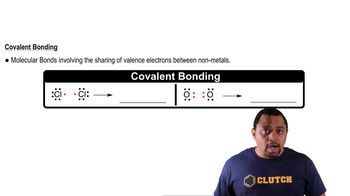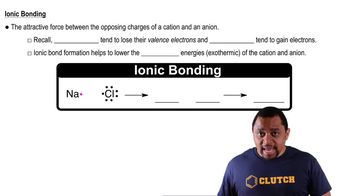Here are the essential concepts you must grasp in order to answer the question correctly.
Covalent Bonding
Covalent bonding occurs when two atoms share one or more pairs of electrons, allowing each atom to attain a stable electron configuration. This type of bond typically forms between nonmetals, where the shared electrons enable both atoms to achieve full outer shells, resulting in the formation of molecules. An example of a covalent bond is the bond between two hydrogen atoms in a hydrogen molecule (H2).
Recommended video:
Ionic Bonding
Ionic bonding is the electrostatic attraction between positively charged ions (cations) and negatively charged ions (anions). This bond forms when one atom donates an electron to another, resulting in the formation of charged ions. Ionic bonds typically occur between metals and nonmetals, such as sodium (Na) and chlorine (Cl) in sodium chloride (NaCl), where sodium loses an electron and chlorine gains one.
Recommended video:
Electronegativity
Electronegativity is a measure of an atom's ability to attract and hold onto electrons in a chemical bond. In covalent bonds, atoms with similar electronegativities share electrons equally, while in ionic bonds, a significant difference in electronegativity leads to the complete transfer of electrons from one atom to another. Understanding electronegativity helps predict the type of bond that will form between two elements.
Recommended video:




